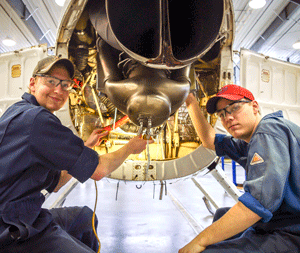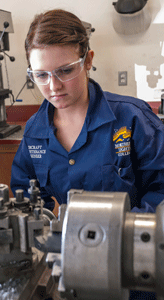

DAWSON CREEK – A diverse fleet of aircraft and a 26,000 square foot hangar are just two reasons that aspiring and current aircraft maintenance engineers look to Northern Lights College for their training.
An aircraft maintenance engineer is vital to the aerospace industry and is responsible for the certification of an aircraft after maintenance, inspection, repair or modification.
At Northern Lights College (NLC) the wide variety of rotary and fixed-wing aircraft allows students in the Aircraft Maintenance Engineering (AME) program to be prepared for what they may encounter in the workforce as aircraft mechanics, directors of maintenance, quality assurance managers, aircraft maintenance instructors, and trainers at aerospace companies.
“The variety of aircraft we have here is unique—students see and work on helicopters and airplanes that they will encounter when they get out into the workforce,” said Hal Hobenshield, AME program chair. “No matter if the student goes into helicopter or fixed wing maintenance engineering, these are the aircraft that they are going to work on as aircraft maintenance engineers in Canada.”
The diverse fleet consists of several helicopters, including a Robinson R44, MD500D, AS350D, Hughes 300C, Bell 205 and 206, and six fixed-wing airplanes, including a Cessna 180, Cessna 310, Piper Aztec 250, King Air B90, and British Aerospace JetStream 31.
The Jetstream 31 is different from the other fixed-wing aircraft in the AME program because it has two hydraulic systems, two electrical systems and a different type of maintenance planning.
“Having access to a fixed-wing aircraft of this type will fill a void that has existed in the formal hands-on training we have been able to provide our students,” said Hobenshield. “Prior to this donation, we did not have a Commuter category aircraft, and this one meets those requirements, which is a significant benefit for students in our 15-month Basic Training program.”
Located in Dawson Creek and designated as a Centre of Excellence in Aerospace, the hangar is home to Basic Training and Type Training programs. When the program began in 1981, the fleet consisted of three planes – a de Havilland Canada DHC-2 Beaver, an Alouette helicopter, and a Piper PA-50 Aztec.
The 15-month Basic Training program is designed to take a student with little or no previous experience and provide the necessary skills to seek employment as an apprentice aircraft maintenance engineer with a Category M1 or M2 licence. An M1 or M2 licence is determined by aircraft type and propulsion system. M1 classification includes gliders, small piston powered and small turboprop aircraft. M2 classification includes all turbojet aircraft.
Basic Training consists of about 45 per cent of theoretical classroom training and 55 per cent practical experience through hands-on training on the College’s aircraft fleet. Some of the areas covered in the NLC Basic Training program include aviation law, theory of flight, power plants (turbine and piston), airframe structures and systems, hydraulics and electrical and avionics systems.
According to Canadian Aviation Regulations (CARs), in order for a student to present a licence application for either Category M1 or M2, AME training must include the following components: task training, experience working on aircraft and successful completion of the CARs exam. NLC’s program satisfies the training requirement and provides 1.5 years of the four-year experience requirement.
David Hill, in third and final term in the Basic program, is very pleased with his decision to pursue a career as an AME.
“I had no idea what I wanted to do after high school. My brother went through the same program a few years ago. He is now working in the industry and he absolutely loves it. Getting into the AME program at NLC has probably been the best thing that has ever happened to me. It is challenging and it is fun. As hard as it gets sometimes, I know that it is all going to be worth it. You are always learning something new,” said Hill.
Type Training involves individual courses, lasting from 5-10 days in duration, on eight different helicopter airframes or turbine engines, and is designed for certified aircraft maintenance engineers to gain additional knowledge. Courses include Bell 205A-1, 206 and 206L airframes. Engine courses include the Honeywell T53 series (Lycoming) and Lycoming LTS 101 series motors. There are also online electrical systems courses for the Bell 206-series aircraft.
Being able to offer the Type Training courses has benefits to the industry as a whole in Canada.
“Canadian employers do not have to send their engineers to the U.S. to get qualified for a specific airframe or turbo engine course,” said Andy Cole, a longtime AME instructor at NLC, and a 1983 program graduate.
At the same time, NLC’s Basic Training students can interact with experienced professionals who can share their knowledge.
“As many aviation professionals have found during their careers, making industry contacts is often key to obtaining employment, something that NLC, with its Type Training courses, helps facilitate for its AME students by bringing industry into the hangar,” said Cole.
Intakes for the Basic program occur in September and February, and currently there is room in the February 2014 intake. For more information, check the program page on the NLC website at nlc.bc.ca, or contact Hobenshieldemail at 250-784-7503. “Student for a Day” sessions are available, where potential applicants can experience a day in the program. To begin the enrolment process, click the Apply Now button or contact Student Services at an NLC campus 1-866-463-6652.
 |
THE FLEET
Brief histories of some of the aircraft that comprise the NLC fleet are provided below.
PIPER AZTEC 250: The oldest aircraft in the AME program dating back to the program’s start in 1981, four-to-six seat twin-engine light aircraft manufactured by Piper Aircraft. The Piper Aztec has seen more maintenance done on it over the years by NLC students than all other aircraft combined.
Students use this plane to practice the following mechanical procedures: 100 hour inspection, engine removal/replacement, weight/balance, landing gear/brakes/tires removal and replacement; remove/replace landing gear leg (actuator); and remove/replace landing gear retraction mechanisms/retraction extensions.
The Piper also has the unique distinction of being the only aircraft in the hangar that sports the original logo of the AME program. This logo, which can be found on the Facebook pagenew window of the AME program, was created by the first graduating class in 1981-82.
CESSNA 180: Nicknamed the “Skywagon,” the Cessna 180 seats up to six people, and was produced between 1953 and 1981 by the Cessna Aircraft Company in Kansas. For NLC, it was purchased at the suggestion of a member of the program’s Industry Advisory Committee to replace the de Havilland Canada DHC-2 Beaver, one of the original three aircraft in the NLC fleet, to provide students with a plane to practice removing the landing gear and replacing it with floats or skis.
The Cessna 180 was discovered at a Vancouver marina, and was flown to Dawson Creek by local businessman Larry Moody, a member of the Program Advisory Committee. The plane was rigged with floats and landed on the grey water lagoon near the airport and then was transported to the College.
BEECHCRAFT KING AIR 90B: A twin-turboprop aircraft with PT6A-20 engines was also acquired at the recommendation of the Industry Advisory Committee to provide a more current training aid for turbine engines, fixed wing, flight control, environmental and avionics systems.
Transport Canada was liquidating some of its fleet assets by public auction, including three King Air B90 turbprop planes, when NLC successfully bid $120,000 on one of the three planes based on age and time left on the engines. Dan Wuthrich, a member of the Industry Advisory Committee, volunteered to fly the plane from Ottawa to Dawson Creek.
Wuthrich’s flight was a unique one as he landed on Highway 2 rather than the airport runway so new fencing at the airport did not have to be dismantled in order to transport the plane to the Dawson Creek Campus.
 |
BELL 205 UH1 (“Huey”): The most iconic aircraft in the AME fleet, this Vietnam War-era military helicopter is recognizable by its round-windowed cockpit, large cargo doors, and long, two-bladed main rotor blades. It was developed in 1952 as a medical evacuation and utility helicopter for the United States Army.
This particular Bell 205 was used by the U.S. Army and the New York National Guard until it was decommissioned in the early 1990s and eventually relocated to Mesa, Arizona. It is the only Bell 205 in Canada at a post-secondary institution that has not been repainted. When it was first purchased, there was no money in the budget to strip and repaint it, and since then, students, staff and visitors have asked the department to leave it with its original military colours and markings.
NLC acquired the helicopter in 2002, because it satisfied the training demands of Transport Canada, industry and the College. It was purchased for a fraction of the cost of a civilian version at $90,000 (versus a Bell 206 at $1.5 million.)
 |
BRITISH AEROSPACE JETSTREAM 31: The largest aircraft in the NLC fleet was built in 1986, and is the first commuter plane owned by NLC. The small twin-turboprop airliner has a pressurized fuselage and is powered by Garrett TPE-331-20 engines.
The Jetstream 31 was donated by Swanberg Air (Landsman Properties Ltd) and the Swanberg family, in memory of Sylvan Swanberg, who died in 2011. Swanberg had been a long-time businessman in the Peace Region in B.C. and Alta. The family’s generosity also included the donation of aircraft tools and parts from the Swanberg shop including $22,000 worth of parts, nine aircraft jacks, two hydraulic service carts and a $20,000 pressurization device.
 |
HUGHES 300C: A light utility and training helicopter, originally developed by Hughes Helicopters and later manufactured by Schweizer Aircraft. With its three-blade main rotor and piston-powered engine, it is a cost-effective platform for training, agricultural and police work.
NLC acquired the helicopter in 2013 through a generous donation from the Dwyer family of Valleyview, Alta., in memory of Tim Dwyer, a Valleyview farmer and businessman who died in 2010 at the age of 63.
The helicopter displays the owner’s initials “TJD”, and will be used for a wide range tasks including: the 100-hour inspection, tail rotor strikes, heat muffler inspection, weight and balance, and configuration changes. Once the aircraft is incorporated into the program curriculum, students will take it apart and reassemble it at least four or five times a year.